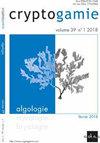Melanothamnus macaronesicus Rodríguez-Buján & Díaz-Tapia, sp. nov. (Rhodomelaceae, Rhodophyta): A New Turf-Forming Species from the Azores and the Canary Islands
IF 1.5
4区 生物学
Q3 MARINE & FRESHWATER BIOLOGY
引用次数: 5
Abstract
ABSTRACT The use of molecular tools in red algal diversity surveys often reveals the existence of undescribed species. Here, we report a new Macaronesian turf-forming red alga in the otherwise mostly Pacific genus Melanothamnus Bornet & Falkenberg. This new taxon, Melanothamnus macaronesicus Rodríguez-Buján & Díaz-Tapia, sp. nov. is described based on morphological and molecular (rbcL gene) evidence. Morphologically, it differs from other Melanothamnus taxa by a combination of characters that includes its decumbent habit with an extensive system of prostrate axes, small size (≤2.5 cm), four ecorticate pericentral cells, unbranched to once-branched trichoblasts and spermatangial branches formed on the first dichotomy of trichoblasts that have a sterile apical cell. Molecularly, this new species differs from its congeners by sequence divergence ≥3.3% in the rbcL gene. Current known distribution of M. macaronesicus Rodríguez-Buján & Díaz-Tapia, sp. nov. is restricted to Macaronesia, suggesting that it could be endemic to this archipelago. Our findings suggest that endemicity among red algae might be more common than previously thought in this bioregion, particularly among easily overlooked turf-forming species.Melanothamnus macaronesicus Rodríguez-Buján & Díaz-Tapia, sp. 11 . (Rhodomelaceae, rhodophyia):来自亚速尔群岛和加那利群岛的一个新的草坪形成物种
在红藻多样性调查中,分子工具的使用往往揭示了未描述物种的存在。在这里,我们报告了一种新的Macaronesian草坪形成红藻,在其他主要是太平洋属Melanothamnus Bornet & Falkenberg。基于形态学和分子(rbcL基因)证据描述了这个新的分类群,Melanothamnus macaronesicus Rodríguez-Buján & Díaz-Tapia, sp. 11 .。从形态学上看,它与其他黑毛目类群的不同之处在于其多种特征的组合,包括其卧卧习性,具有广泛的匍匐轴系统,体积小(≤2.5 cm),四个皮质中心周围细胞,未分枝到曾经分枝的毛胚细胞和在具有不育顶端细胞的毛胚细胞的第一个二分法上形成的精管分支。在分子结构上,该新种与同系种的rbcL基因序列差异≥3.3%。目前已知的M. macaronesicus Rodríguez-Buján & Díaz-Tapia, sp. 11的分布仅限于Macaronesia,这表明它可能是该群岛特有的。我们的研究结果表明,红藻的地方性可能比以前认为的在这个生物区域更普遍,特别是在容易被忽视的草皮形成物种中。
本文章由计算机程序翻译,如有差异,请以英文原文为准。
求助全文
约1分钟内获得全文
求助全文
来源期刊

Cryptogamie Algologie
生物-海洋与淡水生物学
CiteScore
2.60
自引率
7.70%
发文量
11
审稿时长
>12 weeks
期刊介绍:
Cryptogamie is a fast-track and peer-reviewed journal of international scope publishing in English only. It accepts original papers and review articles on the taxonomy, biology and ecology of all cryptogams. An issue of Cryptogamie may be devoted to a single topic, under the responsibility of guest editor(s). All articles published in Cryptogamie are compliant with the different nomenclatural codes. A copyright assignment will be signed by the authors before publication.
Cryptogamie, Algologie accepts articles on systematics as well as ecology and evolution of any kind of algae (including Cyanobacteria).
 求助内容:
求助内容: 应助结果提醒方式:
应助结果提醒方式:


